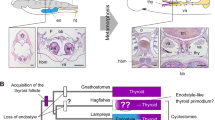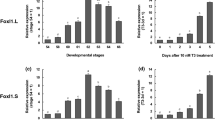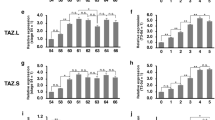Abstract
Due to similarities in iodine concentrations and peroxidase activities, the thyroid in vertebrates is considered to originate from the endostyle of invertebrate chordates even though it is a glandular (mucus-producing) organ for aquatic suspension feeding. Among chordates with an endostyle, urochordates are useful evolutionary research models for the study of vertebrate traits. The ascidian Ciona intestinalis forms an endostyle with specific components of glandular- and thyroid-related elements, and molecular markers have been identified for these components. Since we previously examined a simple endostyle in the larvacean Oikopleura dioica, the expression of the thyroid-related transcription factor genes, Ciona Nkx2-1 and FoxE, was perturbed by TALEN-mediated gene knockout in the present study to elucidate the shared and/or divergent features of a complex ascidian endostyle. The knockout of Ciona Nkx2-1 and FoxE exerted different effects on the morphology of the developing endostyle. The knockout of Nkx2-1 eliminated the expression of both glandular and thyroidal differentiation marker genes, e.g., vWFL1, vWFL2, CiEnds1, TPO, and Duox, while that of FoxE eliminated the expression of the differentiation marker genes, TPO and CiEnds1. The supporting element-related expression of Pax2/5/8a, Pax2/5/8b, FoxQ1, and β-tubulin persisted in the hypoplastic endostyles of Nkx2-1- and FoxE-knockout juveniles. Although the gene regulation of ascidian-specific CiEnds1 remains unclear, these results provide insights into the evolution of the vertebrate thyroid as well as the urochordate endostyle.







Similar content being viewed by others
References
Bassham S, Cañestro C, Postlethwait JH (2008) Evolution of developmental roles of Pax2/5/8 paralogs after independent duplication in urochordate and vertebrate lineages. BMC Biol 6:35. https://doi.org/10.1186/1741-7007-6-35
Boller S, Grosschedl R (2014) The regulatory network of B-cell differentiation: a focused view of early B-cell factor 1 function. Immunol Rev 261:102–115. https://doi.org/10.1111/imr.12206
Cermak T, Doyle EL, Christian M, Wang L, Zhang Y, Schmidt C, Baller JA, Somia NV, Bogdanove AJ, Voytas DF (2011) Efficient design and assembly of custom TALEN and other TAL effector-based constructs for DNA targeting. Nucleic Acids Res 39:e82. https://doi.org/10.1093/nar/gkr218
Colin IM, Denef JF, Lengelé B, Many MC, Gérard AC (2013) Recent insights into the cell biology of thyroid angiofollicular units. Endocr Rev 34:209–238. https://doi.org/10.1210/er.2012-1015
Danks G, Campsteijn C, Parida M, Butcher S, Doddapaneni H, Fu B, Petrin R, Metpally R, Lenhard B, Wincker P, Chourrout D, Thompson EM, Manak JR (2013) OikoBase: a genomics and developmental transcriptomics resource for the urochordate Oikopleura dioica. Nucleic Acids Res 41:1–9. https://doi.org/10.1093/nar/gks1159
Dehal P, Boore JL (2005) Two rounds of whole genome duplication in the ancestral vertebrate. PLoS Biol 3:e314. https://doi.org/10.1371/journal.pbio.0030314
Dehal P, Satou Y, Campbell RK, Chapman J, Degnan B, De Tomaso A, Davidson B, Di Gregorio A, Gelpke M, Goodstein DM, Harafuji N, Hastings KE, Ho I, Hotta K, Huang W, Kawashima T, Lemaire P, Martinez D, Meinertzhagen IA, Necula S, Nonaka M, Putnam N, Rash S, Saiga H, Satake M, Terry A, Yamada L, Wang HG, Awazu S, Azumi K, Boore J, Branno M, Chin-Bow S, DeSantis R, Doyle S, Francino P, Keys DN, Haga S, Hayashi H, Hino K, Imai KS, Inaba K, Kano S, Kobayashi K, Kobayashi M, Lee BI, Makabe KW, Manohar C, Matassi G, Medina M, Mochizuki Y, Mount S, Morishita T, Miura S, Nakayama A, Nishizaka S, Nomoto H, Ohta F, Oishi K, Rigoutsos I, Sano M, Sasaki A, Sasakura Y, Shoguchi E, Shin-i T, Spagnuolo A, Stainier D, Suzuki MM, Tassy O, Takatori N, Tokuoka M, Yagi K, Yoshizaki F, Wada S, Zhang C, Hyatt PD, Larimer F, Detter C, Doggett N, Glavina T, Hawkins T, Richardson P, Lucas S, Kohara Y, Levine M, Satoh N, Rokhsar DS (2002) The draft genome of Ciona intestinalis: insights into chordate and vertebrate origins. Science 298:2157–2167. https://doi.org/10.1126/science.1080049
Delsuc F, Philippe H, Tsagkogeorga G, Simion P, Tilak MK, Turon X, López-Legentil S, Piette J, Lemaire P, Douzery EJP (2018) A phylogenomic framework and timescale for comparative studies of tunicates. BMC Biol 16:39. https://doi.org/10.1186/s12915-018-0499-2
Dunn AD (1974) Ultrastructural autoradiography and cytochemistry of the iodine-binding cells in the ascidian endostyle. J Exp Zool 188:103–123. https://doi.org/10.1002/jez.1401880111
Fagman H, Nilsson M (2010) Morphogenesis of the thyroid gland. Mol Cell Endocrinol 323:35–54. https://doi.org/10.1016/j.mce.2009.12.008
Fernández LP, López-Márquez A, Santisteban P (2014) Thyroid transcription factors in development, differentiation and disease. Nat Rev Endocrinol 11:29–42. https://doi.org/10.1038/nrendo.2014.186
Fredriksson G, Öfverholm T, Ericson LE (1985) Ultrastructural demonstration of iodine binding and peroxidase activity in the endostyle of Oikopleura dioica (Appendicularia). Gen Comp Endocrinol 58:319–327. https://doi.org/10.1016/0016-6480(85)90348-x
Fredriksson G, Öfverholm T, Ericson LE (1988) Iodine binding and peroxidase activity in the endostyle of Salpa fusiformis, Thalia democratica, Dolioletta gegenbauri and Doliolum nationalis (Tunicata, Thaliacea). Cell Tissue Res 253:403–411. https://doi.org/10.1007/BF00222297
Fujita H, Nanba H (1971) Fine structure and its functional properties of the endostyle of ascidians, Ciona intestinalis. A part of phylogenetic studies of the thyroid gland. Z Zellforsch Mikrosk Anat 121:455–469. https://doi.org/10.1007/BF00560154
Fujita H, Sawano F (1979) Fine structural localization of endogeneous peroxidase in the endostyle of ascidians, Ciona intestinalis. A part of phylogenetic studies of the thyroid gland. Arch Histol Jpn 42:319–326. https://doi.org/10.1679/aohc1950.42.319
Gee H (1996) Before the Backbone. Chapman & Hall London. https://doi.org/10.1017/S0016756897306980
Hiruta J, Mazet F, Ogasawara M (2006) Restricted expression of NADPH oxidase/peroxidase gene (Duox) in zone VII of the ascidian endostyle. Cell Tissue Res 326:835–841. https://doi.org/10.1007/s00441-006-0220-6
Hiruta J, Mazet F, Yasui K, Zhang P, Ogasawara M (2005) Comparative expression analysis of transcription factor genes in the endostyle of invertebrate chordates. Dev Dyn 233:1031–1037. https://doi.org/10.1002/dvdy.20401
Kawai N, Ogura Y, Ikuta T, Saiga H, Hamada M, Sakuma T, Yamamoto T, Satoh N, Sasakura Y (2015) Hox10-regulated endodermal cell migration is essential for development of the ascidian intestine. Dev Biol 403:43–56. https://doi.org/10.1016/j.ydbio.2015.03.018
Kishi K, Hayashi M, Onuma TA, Nishida H (2017) Patterning and morphogenesis of the intricate but stereotyped oikoplastic epidermis of the appendicularian, Oikopleura dioica. Dev Biol 428:245–257. https://doi.org/10.1016/j.ydbio.2017.06.008
Kluge B, Renault N, Rohr KB (2005) Anatomical and molecular reinvestigation of lamprey endostyle development provides new insight into thyroid gland evolution. Dev Genes Evol 215:32–40. https://doi.org/10.1007/s00427-004-0450-0
Kobayashi K, Maeda K, Tokuoka M, Mochizuki A, Satou Y (2018) Controlling cell fate specification system by key genes determined from network structure. iScience 4:281–293. https://doi.org/10.1016/j.isci.2018.05.004
Mazet F (2002) The Fox and the thyroid: the amphioxus perspective. BioEssays 24:696–699. https://doi.org/10.1002/bies.10128
Mazet F, Luke GN, Shimeld SM (2005) The amphioxus FoxQ1 gene is expressed in the developing endostyle. Gene Expr Patterns 5:313–315. https://doi.org/10.1016/j.modgep.2004.10.004
Medvedovic J, Ebert A, Tagoh H, Busslinger M (2011) Pax5: a master regulator of B cell development and leukemogenesis. Adv Immunol 111:179–206. https://doi.org/10.1016/b978-0-12-385991-4.00005-2
Müller W (1873) Über die Hypobranchialrinne der Tunicaten und deren Vorhandensein bei Amphioxus und den Cyclostomen. Jena Z Med Naturwiss 7:327–332
Morita R, Onuma TA, Manni L, Ohno N, Nishida H (2020) Mouth opening is mediated by separation of dorsal and ventral daughter cells of the lip precursor cells in the larvacean, Oikopleura dioica. Dev Genes Evol 230:315–327. https://doi.org/10.1007/s00427-020-00667-4
Nakayama S, Ogasawara M (2017) Compartmentalized expression patterns of pancreatic- and gastric-related genes in the alimentary canal of the ascidian Ciona intestinalis: evolutionary insights into the functional regionality of the gastrointestinal tract in Olfactores. Cell Tissue Res 370:113–128. https://doi.org/10.1007/s00441-017-2627-7
Nilsson M, Fagman H (2017) Development of the thyroid gland. Development 144:2123–2140. https://doi.org/10.1242/dev.145615
Ogasawara M (2000) Overlapping expression of amphioxus homologs of the thyroid transcription factor-1 gene and thyroid peroxidase gene in the endostyle: insight into evolution of the thyroid gland. Dev Genes Evol 210:231–242. https://doi.org/10.1007/s004270050309
Ogasawara M, Di Lauro R, Satoh N (1999a) Ascidian homologs of mammalian thyroid peroxidase genes are expressed in the thyroid-equivalent region of the endostyle. J Exp Zool 285:158–169. https://doi.org/10.1002/(sici)1097-010x(19990815)285:2%3c158::aid-jez8%3e3.0.co;2-0
Ogasawara M, Di Lauro R, Satoh N (1999b) Ascidian homologs of mammalian thyroid transcription factor-1 gene are expressed in the endostyle. Zool Sci 16:559–565. https://doi.org/10.2108/zsj.16.559
Ogasawara M, Minokawa T, Sasakura Y, Nishida H, Makabe KW (2001a) A large-scale whole-mount in situ hybridization system: rapid one-tube preparation of DIG-labeled RNA probes and high throughput hybridization using 96-well silent screen plates. Zoolog Sci 18:187–193. https://doi.org/10.2108/zsj.18.187
Ogasawara M, Sasaki A, Metoki H, Shin-i T, Kohara Y, Satoh N, Satou Y (2002) Gene expression profiles in young adult Ciona intestinalis. Dev Genes Evol 212:173–185. https://doi.org/10.1007/s00427-002-0230-7
Ogasawara M, Satoh N (1998) Isolation and characterization of endostyle-specific genes in the ascidian Ciona intestinalis. Biol Bull 195:60–69. https://doi.org/10.2307/1542776
Ogasawara M, Satoh N, Shimada Y, Wang Z, Tanaka T, Noji S (2006) Rapid and stable buffer exchange system using InSitu Chip suitable for multicolor and large-scale whole-mount analyses. Dev Genes Evol 216:100–104. https://doi.org/10.1007/s00427-005-0031-x
Ogasawara M, Satou Y (2003) Expression of FoxE and FoxQ genes in the endostyle of Ciona intestinalis. Dev Genes Evol 213:416–419. https://doi.org/10.1007/s00427-003-0342-8
Ogasawara M, Shigetani Y, Suzuki S, Kuratani S, Satoh N (2001b) Expression of Thyroid transcription factor-1 (TTF-1) gene in the ventral forebrain and endostyle of the agnathan vertebrate, Lampetra japonica. Genesis 30:51–58. https://doi.org/10.1002/gene.1032
Olsson R (1963) Endostyles and endostylar secretions: a comparative histochemical study. Acta Zoologica. Bd. XLZV. https://doi.org/10.1111/j.1463-6395.1963.tb00411.x
Olsson R (1965) The cytology of the endostyle of Oikopleura dioica. Ann N Y Acad Sci 118:1038–1051. https://doi.org/10.1111/j.1749-6632.1965.tb40170.x
Omotezako T, Onuma TA, Nishida H (2015) DNA interference: DNA-induced gene silencing in the appendicularian Oikopleura Dioica. Proc Biol Sci 282:20150435. https://doi.org/10.1098/rspb.2015.0435
Onuma TA, Nakanishi R, Sasakura Y, Ogasawara M (2021) Nkx2-1 and FoxE regionalize glandular (mucus-producing) and thyroid-equivalent traits in the endostyle of the chordate Oikopleura dioica. Dev Biol 477:219–231. https://doi.org/10.1016/j.ydbio.2021.05.021
Ota S, Hisano Y, Muraki M, Hoshijima K, Dahlem TJ, Grunwald DJ, Okada Y, Kawahara A (2013) Efficient identification of TALEN-mediated genome modifications using heteroduplex mobility assays. Genes Cells 18:450–458. https://doi.org/10.1111/gtc.12050
Rosental B, Kowarsky M, Seita J, Corey DM, Ishizuka KJ, Palmeri KJ, Chen S-Y, Sinha R, Okamoto J, Mantalas G, Manni L, Raveh T, Clarke DN, Tsai JM, Newman AM, Neff NF, Nolan GP, Quake SR, Weissman IL, Voskoboynik A (2018) Complex mammalian-like haematopoietic system found in a colonial chordate. Nature 564:425–429. https://doi.org/10.1038/s41586-018-0783-x
Sakuma T, Ochiai H, Kaneko T, Mashimo T, Tokumasu D, Sakane Y, Suzuki K, Miyamoto T, Sakamoto N, Matsuura S, Yamamoto T (2013) Repeating pattern of non-RVD variations in DNA-binding modules enhances TALEN activity. Sci Rep 3:3379. https://doi.org/10.1038/srep03379
Salvatore G (1969) Thyroid hormone biosynthesis in agnatha and protochordata. Gen Comp Endocrinol Suppl 2:535–551. https://doi.org/10.1016/0016-6480(69)90063-X
Sasaki A, Miyamoto Y, Satou Y, Satoh N, Ogasawara M (2003) Novel endostyle-specific genes in the ascidian Ciona intestinalis. Zoolog Sci 20:1025–1030. https://doi.org/10.2108/zsj.20.1025
Sasakura Y, Ogura Y, Treen N, Yokomori R, Park SJ, Nakai K, Saiga H, Sakuma T, Yamamoto T, Fujiwara S, Yoshida K (2016) Transcriptional regulation of a horizontally transferred gene from bacterium to chordate. Proc Biol Sci 283. https://doi.org/10.1098/rspb.2016.1712
Satoh N (2016) Chordate origins and evolution. The Molecular Evolutionary Road to Vertebrates Amsterdam: Academic Press. https://doi.org/10.1016/C2014-0-04068-3
Satou Y, Kawashima T, Shoguchi E, Nakayama A, Satoh N (2005) An integrated database of the Ascidian, Ciona intestinalis: Towards Functional Genomics. Zoolog Sci 22:837–843. https://doi.org/10.2108/zsj.22.837
Satou Y, Nakamura R, Yu D, Yoshida R, Hamada M, Fujie M, Hisata K, Takeda H, Satoh N (2019) A nearly complete genome of Ciona intestinalis type A (C. intestinalis) reveals the contribution of inversion to chromosomal evolution in the genus Ciona. Genome Biol Evol 11:3144–3157. https://doi.org/10.1093/gbe/evz228
Satou Y, Takatori N, Fujiwara S, Nishikata T, Saiga H, Kusakabe T, Shin-I T, Kohara Y, Satoh N (2002) Ciona intestinalis cDNA projects: expressed sequence tag analysis and gene expression profile during embryogenesis. Gene 287:83–96. https://doi.org/10.1016/s0378-1119(01)00826-5
Soukup V, Yong LW, Lu TM, Huang SW, Kozmik Z, Yu JK (2015) The Nodal signaling pathway controls left-right asymmetric development in amphioxus. EvoDevo 6:5. https://doi.org/10.1186/2041-9139-6-5
Stach T, Turbeville JM (2002) Phylogeny of Tunicata inferred from molecular and morphological characters. Mol Phylogenet Evol 25:408–428. https://doi.org/10.1016/s1055-7903(02)00305-6
Swalla BJ, Cameron CB, Corley LS, Garey JR (2000) Urochordates are monophyletic within the deuterostomes. Syst Biol 49:52–64. https://doi.org/10.1080/10635150050207384
Takagi W, Sugahara F, Higuchi S, Kusakabe R, Pascual-Anaya J, Sato I, Oisi Y, Ogawa N, Miyanishi H, Adachi N, Hyodo S, Kuratani S (2022) Thyroid and endostyle development in cyclostomes provides new insights into the evolutionary history of vertebrates. BMC Biol 20:76. https://doi.org/10.1186/s12915-022-01282-7
Thorpe A, Thorndyke MC, Barrington EJ (1972) Ultrastructural and histochemical features of the endostyle of the ascidian Ciona intestinalis with special reference to the distribution of bound iodine. Gen Comp Endocrinol 19:559–571. https://doi.org/10.1016/0016-6480(72)90256-0
Treen N, Yoshida K, Sakuma T, Sasaki H, Kawai N, Yamamoto T, Sasakura Y (2014) Tissue-specific and ubiquitous gene knockouts by TALEN electroporation provide new approaches to investigating gene function in Ciona. Development 141:481–487. https://doi.org/10.1242/dev.099572
Voskoboynik A, Soen Y, Rinkevich Y, Rosner A, Ueno H, Reshef R, Ishizuka KJ, Palmeri KJ, Moiseeva E, Rinkevich B, Weissman IL (2008) Identification of the endostyle as a stem cell niche in a colonial chordate. Cell Stem Cell 3:456–464. https://doi.org/10.1016/j.stem.2008.07.023
Wada H (1998) Evolutionary history of free-swimming and sessile lifestyles in urochordates as deduced from 18S rDNA molecular phylogeny. Mol Biol Evol 15:1189–1194. https://doi.org/10.1093/oxfordjournals.molbev.a026026
Yoshida K, Nakahata A, Treen N, Sakuma T, Yamamoto T, Sasakura Y (2017) Hox-mediated endodermal identity patterns pharyngeal muscle formation in the chordate pharynx. Development 144:1629–1634. https://doi.org/10.1242/dev.144436
Yoshida K, Treen N (2018) TALEN-based knockout system. Adv Exp Med Biol 1029:131–139. https://doi.org/10.1007/978-981-10-7545-2_12
Yoshida K, Treen N, Hozumi A, Sakuma T, Yamamoto T, Sasakura Y (2014) Germ cell mutations of the ascidian Ciona intestinalis with TALE nucleases. Genesis 52:431–439. https://doi.org/10.1002/dvg.22770
Acknowledgements
We thank Dr. Nori Satoh and Dr. Yutaka Satou for providing the Ciona cDNA clones. We thank the laboratory members at the Shimoda Marine Research Center at the University of Tsukuba for their technical support with TALEN-mediated knockout experiments. We also thank Drs. Yutaka Satou, Manabu Yoshida, Reiko Yoshida, and Satoe Aratake and other members working under the National Bio-Resource project (AMED) for supplying Ciona adults and the constructs of plasmid vectors for TALEN-mediated knockout experiments. We thank Ms. Mizuki Ito, Mr. Ippei Yamamura, Ms. Haruka Yamaguchi, Ms. Honoka Nakadai, and the laboratory members of our group for their assistance with the laboratory culture of Ciona juveniles.
Funding
This work was supported by JSPS KAKENHI grant number 20K07221 to M. O., and also by Grants-in-Aid for Scientific Research (KAKENHI) from the JSPS and MEXT Japan to Y. S. (Grant Number 19H03262).
Author information
Authors and Affiliations
Contributions
Y.S., T.O., and M.O. designed the experiments. M.Y. performed ISH and histochemical analyses. T.H. and A.H. performed the knockout and knockdown of genes with the aid of Y.S. M.O. and all coauthors wrote the manuscript.
Corresponding author
Ethics declarations
Ethics approval and consent to participate
This article does not contain any studies with human participants performed by any of the authors. Animals were maintained and used in accordance with the regulations on animal experimentation at the University of Tsukuba and Chiba University.
Competing interests
The authors declare no competing interests.
Additional information
Publisher's Note
Springer Nature remains neutral with regard to jurisdictional claims in published maps and institutional affiliations.
Supplementary Information
Below is the link to the electronic supplementary material.
Rights and permissions
Springer Nature or its licensor holds exclusive rights to this article under a publishing agreement with the author(s) or other rightsholder(s); author self-archiving of the accepted manuscript version of this article is solely governed by the terms of such publishing agreement and applicable law.
About this article
Cite this article
Yamagishi, M., Huang, T., Hozumi, A. et al. Differentiation of endostyle cells by Nkx2-1 and FoxE in the ascidian Ciona intestinalis type A: insights into shared gene regulation in glandular- and thyroid-equivalent elements of the chordate endostyle. Cell Tissue Res 390, 189–205 (2022). https://doi.org/10.1007/s00441-022-03679-w
Received:
Accepted:
Published:
Issue Date:
DOI: https://doi.org/10.1007/s00441-022-03679-w




